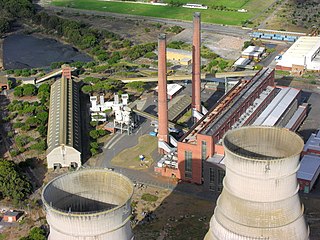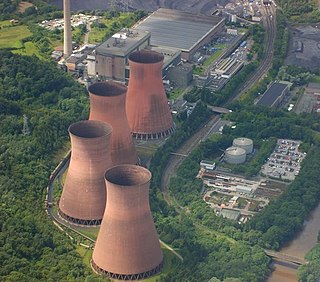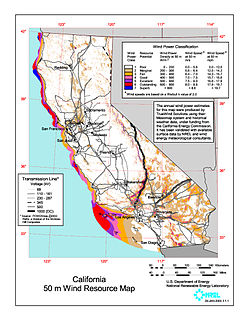
Electricity generation is the process of generating electric power from sources of primary energy. For utilities in the electric power industry, it is the stage prior to its delivery to end users or its storage.

The Lower Colorado River Authority (LCRA) is a nonprofit public utility created in November 1934 by the Texas Legislature. LCRA's mission is to enhance the lives of the Texans it serves through water stewardship, energy and community service. LCRA provides public power, manages the lower Colorado River, builds and operates transmission lines, owns public parks, and offers community services.

A power station, also referred to as a power plant and sometimes generating station or generating plant, is an industrial facility for the generation of electric power. Power stations are generally connected to an electrical grid.

Samuel Insull was a British-born American business magnate. He was an innovator and investor based in Chicago who greatly contributed to create an integrated electrical infrastructure in the United States. Insull created holding companies that purchased utilities and railroads. Insull was responsible for the building of the Chicago Civic Opera House in 1929. Due to the Great Depression, his vast Midwest holding company empire collapsed, and he was accused of profiting personally by selling worthless stock to unsuspecting investors who trusted him because of his position and reputation. Following a seven-week trial, he and 16 co-defendants were acquitted of all charges after two hours of jury deliberation.
Commonwealth Edison, commonly known by syllabic abbreviation as ComEd, is the largest electric utility in Illinois, and the sole electric provider in Chicago and much of Northern Illinois. Its service territory stretches roughly from Iroquois County on the south to the Wisconsin border on the north and from the Iowa border on the west to the Indiana border on the east. For more than 100 years, Commonwealth Edison has been the primary electric delivery services company for Northern Illinois. Today, ComEd is a unit of Chicago-based Exelon Corporation, one of the nation's largest electric and gas utility holding companies. ComEd provides electric service to more than 3.8 million customers across Northern Illinois. The company's revenues total more than $15 billion annually.

Southern California Edison, the largest subsidiary of Edison International, is the primary electricity supply company for much of Southern California. It provides 15 million people with electricity across a service territory of approximately 50,000 square miles. However, the Los Angeles Department of Water and Power, San Diego Gas & Electric (SDG&E), Imperial Irrigation District, and some smaller municipal utilities serve substantial portions of the southern California territory. The northern part of the state is generally served by the Pacific Gas & Electric Company of San Francisco. Other investor-owned utilities (IOUs) in California include SDG&E, PacifiCorp, Bear Valley Electric, and Liberty Utilities.

The Ironbridge power stations refers to a series of two power stations that occupied a site on the banks of the River Severn at Buildwas in Shropshire, England. The Ironbridge B Power Station was operated by E.ON UK but the site is now owned by Haworth Group. The station stands near the Ironbridge Gorge World Heritage Site. Originally powered by coal, they were converted to use 100% biomass fuel. Ironbridge B Power Station stopped generating electricity on 20 November 2015, with the decommissioning process continuing into 2017. The main phase of the 27-month demolition process began at 11:00 GMT on 6 December 2019, commencing with the four cooling towers.

Peaking power plants, also known as peaker plants, and occasionally just "peakers", are power plants that generally run only when there is a high demand, known as peak demand, for electricity. Because they supply power only occasionally, the power supplied commands a much higher price per kilowatt hour than base load power. Peak load power plants are dispatched in combination with base load power plants, which supply a dependable and consistent amount of electricity, to meet the minimum demand.

Inverkip power station was an oil-fired power station in Inverclyde, on the west coast of Scotland. It was closer to Wemyss Bay than Inverkip, and dominated the local area with its 236 m (774 ft) chimney, the third tallest chimney in the UK and Scotland's tallest free-standing structure. In common with other power stations in Scotland it lacked cooling towers; instead, sea water was used as a coolant. The station consisted of three generating units with a combined total rating of 2028 megawatts (MW).

The Fisk Generating Station, also known as Fisk Street Generating Station or Fisk Station is an inactive medium-size, coal-fired electric generating station located at 1111 West Cermak Road in the Pilsen neighborhood of Chicago, Illinois. It was sited near the south branch of the Chicago River to provide access to water for steam and barge traffic for coal, and closed down in 2012.

Eggborough power station was a coal-fired power station in North Yorkshire, England, which was capable of co-firing biomass. It was situated on the River Aire, between the towns of Knottingley and Snaith, deriving its name from the nearby village of Eggborough. The station had a generating capacity of 1,960 megawatts, enough electricity to power 2 million homes, equivalent to the area of Leeds and Sheffield.

Wind power in California had initiative and early development during Governor Jerry Brown's first two terms in the late 1970s and early 1980s. The state's wind power capacity has grown by nearly 350% since 2001, when it was less than 1,700 MW. In 2016, wind energy supplied about 6.9% of California's total electricity needs, or enough to power more than 1.3 million households. Most of California's wind generation is found in the Tehachapi area of Kern County, California, with some large projects in Solano, Contra Costa and Riverside counties as well. California is among the states with the largest amount of installed wind power capacity. In recent years, California has lagged behind other states when it comes to the installation of wind power. It was ranked 4th overall for wind power electrical generation at the end of 2016 behind Texas, Iowa, and Oklahoma. As of 2019, California had 5,973 megawatts (MW) of wind power generating capacity installed.

Grain Power Station is a CCGT power station and former oil-fired power station in Kent, England, with operational capacity of 1,275 megawatts (1,710,000 hp) owned by Uniper.

Dunston Power Station refers to a pair of adjacent coal-fired power stations in the North East of England, now demolished. They were built on the south bank of the River Tyne, in the western outskirts of Dunston in Gateshead. The two stations were built on a site which is now occupied by the MetroCentre. The first power station built on the site was known as Dunston A Power Station, and the second, which gradually replaced it between 1933 and 1950, was known as Dunston B Power Station. The A Station was, in its time, one of the largest in the country, and as well as burning coal had early open cycle gas turbine units. The B Station was the first of a new power station design, and stood as a landmark in the Tyne for over 50 years. From the A Station's opening in 1910 until the B Station's demolition in 1986, they collectively operated from the early days of electricity generation in the United Kingdom, through the industry's nationalisation, and until a decade before its privatisation.
Belle River Power Plant is a major coal- and natural gas-fired power plant owned by Detroit Edison, a subsidiary of DTE Energy. It is located in St. Clair County, Michigan, on the peninsula formed by the St. Clair and Belle rivers. The plant was built across M-29 from the St. Clair Power Plant in East China, Michigan, and shares the coal delivery terminal with it. The Belle River plant also shares cooling water from the St. Clair River with its sister plant. Five oil-fueled internal combustion generators were built in 1981, with a total output 13.75 megawatts. Coal-fired unit 1 of the Belle River plant was completed in 1984, followed by a similar unit 2 in 1985. Each unit has a nameplate capacity of 697.5 MWe, however the coal-fired plant as a whole generates 1260 MWe all year around. In 1999, three peaker natural-gas fired turbines were added, with a total name-plate capacity of 256 MWe.

The West Springfield Generating Station, also known by its corporate name EP Energy Massachusetts, LLC, is a fossil-fuel-fired power plant located in West Springfield, Massachusetts. The station is a "peaking" facility, meaning that it primarily operates during peak electrical demand. The facility consists of two 49-megawatt (MW) combustion turbine generators fueled by natural gas or ultra low-sulphur diesel fuel, one 18 MW jet turbine that is fueled by kerosene, and one 107 MW simple-cycle steam boiler unit burning no. 6 fuel oil, ULSD or natural gas. The station also has a small auxiliary boiler for process and building heat and an emergency back-up generator. The station's management also operates several small remote power generators including two other jet turbines identical to West Springfield 10 which are the Doreen Street unit in Pittsfield, Massachusetts, and Woodland Road unit in Lee, Massachusetts as well as five run-of-river hydroelectric power stations located on the Chicopee and Deerfield Rivers.
Prairie State Energy Campus is a 1,600 megawatt base load, coal-fired, electrical power station and coal mine near Marissa, Illinois southeast of St. Louis, Missouri. Prairie State Energy Campus (PSEC) features low levels of regulated emissions compared to other coal-fired power stations, capturing sulfur from high-sulfur coal mined nearby instead of transporting low-sulfur coal from elsewhere.

Ravenswood Generating Station is a 2,480 megawatt power plant in Long Island City in Queens, New York City, New York. It is owned and operated by LS Power/Helix Energy Solutions Group. The plant is fueled primarily by fuel oil and natural gas which heats the boilers.

Glenwood Generating Station is a power station in Glenwood Landing, New York owned by National Grid USA. It is mainly known for being the former site of an architecturally significant 1920s brick power station. That building and an adjacent 1950s station were demolished over the course of 2013 to 2015, due to their obsolescence as well as the excessive cost of safely retaining the building given its poor condition. Four smaller gas turbine peaking generators remain in operation, as does the Y-50 Cable connection across Long Island Sound.
Yerevan Thermal Power Plant, is a thermal power plant located about 10 kilometres (6.2 mi) from Yerevan, Armenia. An older, obsolete plant was fueled by natural gas and fuel oil, while the new combined-cycle plant is powered by natural gas and has a capacity of 242 megawatts. It produces a quarter of the country's electricity and is responsible for seasonal electricity swaps with Iran. The director general of the power plant is Hovakim Hovhannisyan.

















